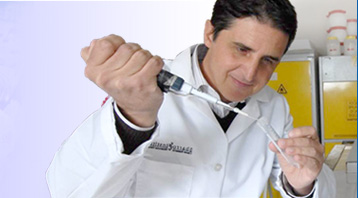 |
 STEM CELL PROGRAM
STEM CELL PROGRAM


|
|
PUBLICATIONS (2004-2008)
Sun, A., Bagella, L., Romano, G. and Giordano, A. From G0 to G1 phase: a view of the role played by the retinoblastoma (Rb) family members in the Rb-E2F pathway. Journal of Cellular Biochemistry, (in press).
Romano, G. Advances in the field of stem cell research: a report on the fifth annual meeting of the International Society for Stem Cell Research, held from June 17 to June 20, 2007 in Cairns, Queensland, Australia. Drug News & Perspectives, (in press).
Fucito, A., Lucchetti, C., Giordano, A. and Romano, G. Genetic and epigenetic alterations in breast cancer: what are the perspectives for clinical practice? The International Journal of Biochemistry & Cell Biology, (in press).
Puca, A., Russo, G., Romano, G. and Giordano, A. Chaotic dynamic stabilities and instabilities of hematopoietic stem cell growth plasticity. Journal of Cellular Physiology, (in press).
Romano, G. The standpoint of gene therapy programs. Drug News & Perspectives, 20: 335-343, 2007.
Giordano, A., Rossi, A., Romano, G. and Bagella, L. Tumor suppressor pRb2/p130 gene and its derived product Spa310 spacer domain as perspective candidates for cancer therapy. Journal of Cellular Physiology, 213: 403-406, 2007.
Romano, G. and Giordano, A. American Society of Gene Therapy: tenth annual meeting. IDrugs, 10: 534-537, 2007.
Romano, G. Viral oncology and development of preventive vaccines. Drugs of the Future, 32: 367-373, 2007.
Romano, G. Current development of non-viral-mediated gene transfer. Drug News & Perspectives, 20: 227-231, 2007.
Giordano, A., Fucito, A., Romano, G. and Marino, I.R. Carcinogenesis and environment: the cancer stem cell hypothesis and implications for the development of novel therapeutics and diagnostics. Frontiers in Bioscience, 12: 3475-3482, 2007.
Romano, G., Macaluso, M., Lucchetti, C. and Iacovitti, L. Transcription and epigenetic profile of the promoter, first exon and first intron of the human tyrosine hydroxylase gene. Journal of Cellular Physiology, 211: 431-438, 2007.
Romano, G. Perspectives and controversies in the field of stem cell research. Drug News & Perspectives, 19: 433-439, 2006.
Romano, G. Advances and perspectives in the field of gene transfer technology. Drug News & Perspectives, 19: 359-368, 2006.
Romano, G. The controversial role of adenoviral-mediated gene transfer in gene therapy programs: where do we stand? Drug News & Perspectives, 19: 99-106, 2006.
Jin, H.*, Romano, G.*, Marshall, C., Donaldson, A.E., Suon, S. and Iacovitti, L. (*These two authors equally contributed to this work). Tyrosine hydroxylase gene regulation in human neuronal progenitor cells does not depend on Nurr1 as in the murine and rat systems. Journal of Cellular Physiology, 207: 49-57, 2006.
Romano, G. The role of adult stem cells in carcinogenesis. Drug News & Perspectives, 18: 555-559, 2005.
Romano, G. Current development of adeno-associated viral vectors. Drug News & Perspectives, 18: 311-316, 2005.
Romano, G., Suon, S., Jin, H., Donaldson, A.E. and Iacovitti, L. Characterization of five evolutionary conserved regions of the human tyrosine hydroxylase (TH) promoter: implications for the engineering of a human TH minimal promoter assembled in a self-inactivating lentiviral vector system. Journal of Cellular Physiology, 204: 666-677, 2005.
Romano, G. Current development of lentiviral-mediated gene transfer. Drug News & Perspectives, 18: 128-134, 2005.
Romano, G. Stem cell transplantation therapy: controversy over ethical issues and clinical relevance. Drug News & Perspectives, 17: 637-645, 2004.
Tonini, T., Gabellini, C., Bagella, L., D’Andrilli, G., Masciullo, V., Romano, G., Scambia, G., Zupi, G. and Giordano, A. pRB2/p130 decreases sensitivity to apoptosis induced by camptothecin and doxorubicin but not by taxol. Clinical Cancer Research, 10: 8085-8093, 2004.
Giordano, A. and Romano, G. Eds. “Cell cycle control and dysregulation protocols: cyclins, cyclin-dependent kinases and other factors. Methods in Molecular Biology”, The Humana Press Inc., July 2004.
Romano, G. Systems for regulated or tissue specific gene expression. Drug News & Perspectives, 17: 85-90, 2004.
|
|




 Umberto Galderisi, Ph.D.
Umberto Galderisi, Ph.D.